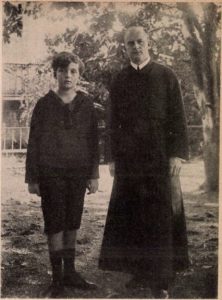Otto von Habsburg and his siblings, 1924
“We are a unique nation in this world, because Saint Stephen founded a state that was able to survive for a thousand years.”
– said Otto von Habsburg in his speech in Nagymaros on August 20, 1994, thirty years ago,[1] indicating the great importance he attached to celebrating St. Stephen’s Day in Hungary. But even when he could not do so, during his time in exile, he commemorated every year the founder of the state, the first Hungarian king, St. Stephen of the Árpád dynasty.
Shortly after the death of the founder of the state, the conscious cultivation of his memory began, for which the subsequent turbulent decades and the difficulties of the succession to the throne provided a suitable basis. It was a remarkable achievement of King Ladislaus I that on 20 August 1083 Pope Gregory VII canonised King Stephen – together with Gerard, former bishop and martyr of Csanád and the son of Stephen, Prince Emeric, who had died at a young age. From then on, the notion of the Regnum Marianum, linked to Stephen, made the date particularly important in defining the country’s Catholic self-image, gradually transforming it from a Catholic feast day into a public holiday. In 1686, Pope Innocent XI elevated St. Stephen to the rank of a universal saint of the Church. In 1771, however, Pope Clement XIV decreed that the feast should be removed from the liturgical calendar, but it was he who intervened to ensure that the founder of the House of Habsburg-Lorraine, Maria Theresa, could bring St. Stephen’s Holy Right Hand back home and that Hungarians could continue to officially celebrate 20 August. Following the Austro-Hungarian Compromise of 1867, Franz Joseph abolished the prohibition of celebrating St. Stephen’s Day and made it a public holiday in 1891. In 1938, during the commemorative year of St. Stephen, the National Assembly officially declared 20 August a national holiday, and after the “intermezzo” of state socialism, the national holiday in honour of the founder of the state was restored by Article VIII of the 1991 Act.[2]
The last Crown Prince of the House of Habsburg-Lorraine, Otto von Habsburg, also had many ties to this day. After the tragic death of the last Hungarian king, Charles IV, on Madeira, the royal family moved first to Madrid in 1922 and then to Lequeitio in the Basque Country in 1923. During the exile, the fomer court parish priest of Charles IV, Pál Zsámboky, and Benedictine monks (Vendel Solymos, Róbert Vlasics) were among those commissioned to teach the little archdukes Hungarian. This meant not only learning the language itself, but also getting acquainted with the history of Hungary and the significance of national holidays.
The diaries, held at our Foundation and currently under processing, are the primary source of information on the years of exile of the imperial and royal family, giving a detailed account of the children’s daily life and insight into the preparations for St. Stephen’s Day. An added peculiarity is that these documents were not the work of one hand alone: many of them were written by Count Heinrich August von Degenfeld-Schonburg, one of the most loyal benefactors of the family, while a number of these diaries were kept by Countess Marie-Therese Korff Schmising-Kerssenbrock (‘Korffi’), one of the governesses of the children.
One of the diaries, written by Heinrich Degenfeld-Schonburg in 1924, contains details of his stay in Lequeitio on 20 August. A hundred years ago, on the occasion of St. Stephen’s Day, their teacher, Vendel Solymos, was teaching the Crown Prince and his brothers Hungarian religious songs, which they had begun practising two days earlier. The Hungarian songs were sung during the Holy Mass on the feast day, accompanied by Father Solymos on the harmonium (pump organ).[3]

Otto von Habsburg and Vendel Solymos, 1930 |
Over the years, the children have become accustomed to singing in Hungarian on St. Stephen’s Day. A diary entry by one of the ladies-in-waiting, Viktoria von Mensdorff-Pouilly, dated 20 August 1928, bears witness to this: “In honour of St. Stephen, the Highnesses received Holy Communion for the homeland and for themselves, with Father Andlau preaching. At the Holy Mass they sang Hungarian songs, which they had been practising diligently during the previous two days, and which His Majesty [Otto – M. P.] knew exceptionally well.”[4]
It was also due to his upbringing that Otto von Habsburg understood well the significance of the holiday in Hungarian identity. We know from his later Hungarian correspondence that after the fall of communism he frequently attended the Processions of the Holy Right in Budapest, and that he accepted several invitations to participate in the celebrations organised by Hungarian municipalities on this occasion.[5] This, no doubt, was connected with the fact that for Otto von Habsburg, King Stephen was not only a saint, a Hungarian royal precedent, but also a person who had set an exemplary programme. Stephen I strengthened the Kingdom of Hungary by bringing it firmly into the Western, Latin Christian community. This was in line with Otto’s ambition in the 1980s and 1990s for Hungary to regain its sovereignty as part of a Western, democratic European community defending Christian values.
The date of the Pan-European Picnic, organised thirty-five years ago under the patronage of Otto von Habsburg, which led to the fall of the Iron Curtain, did not fall on 19 August by chance. The opening of the Austro-Hungarian border on 20 August 1989 marked the beginning of a new era in the history of the European nations, and helped Hungary to return to the path set by St. Stephen with his political credo dating back almost a thousand years.
Péter Matolcsi
[1] Quote from a speech given by Otto von Habsburg in Nagymaros, 20 August 1994. Without author: Let us uphold the legacy of the Saint King, the faith and the Hungarian nation! Nagymarosi Hírek, 1994.09.01. 1.
[2] Zoltán Oszkár Szőts: Augusztus 20. jelentésváltozásai – az ünnep története 1038-tól napjainkig. (“Changes in the Meaning of 20 August – The history of the Holiday from 1038 to the Present Days”.) Újkor.hu. 20 August 2022 (Source: https://ujkor.hu/content/augusztus-20-jelentesvaltozasai-az-unnep-tortenete-1038-tol-napjainkig. Last accessed on 10.08.2024.)
[3] „Heute, am Tage des hl. Stephan, empfingen S.M. u. Erzhg. Robert die hl. Kommunion während der von P. Solymos um 8h celebrierter hl. Messe. – Um 9h las P. Andlau die hl. Messe, während derselben wurden ungarische Lieder gesungen, P. Solymos spielte am Harmonium.” – HOAL I-1-d-35 6 May 1924 – 20 August 1924
[4] „Die Hoheiten opferten die hl Comunion auf zu Ehren des hl. Stefan für die Heimat und für sich, so auch die hl Messe mit einer Predigt von Pater Andlau. In der hl Messe wurden Ung. Lieder gesungen die schon in den 2 letzten Tagen fleißig geübt werden u besonders S.M. gut kannte.” – HOAL I-1-d-40 19 August 1928 – 6 October 1928
[5] Beyond the event of the article’s introduction, for example, the Municipality of Tiszaújváros invited Otto, who was awarded the honorary citizenship of the city, to the 20th of August celebrations on several occasions between 1995 and 2006 (HOAL I-2-c-Farkas Zoltán)


